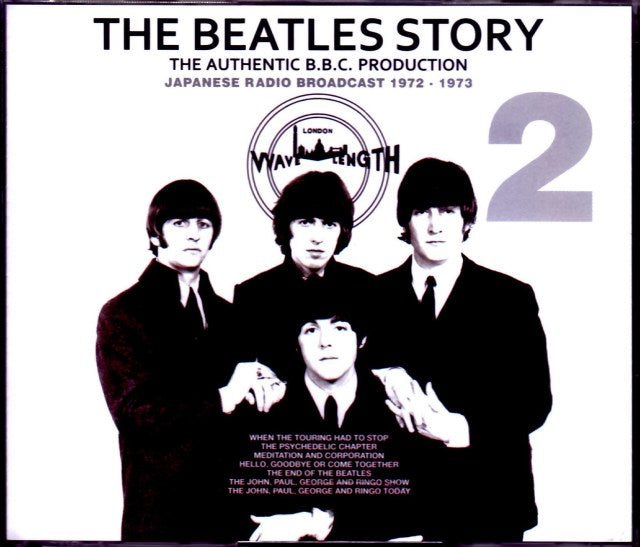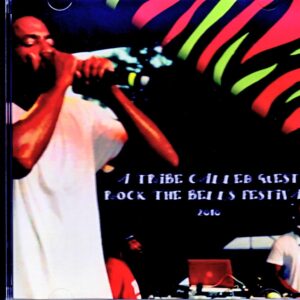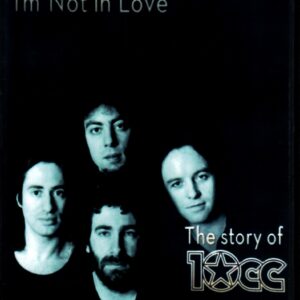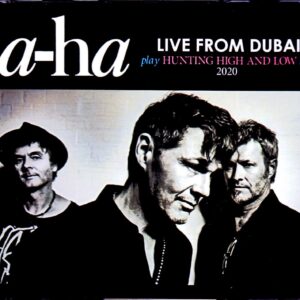Description
*The information is common to Vol.1 and Vol.2. In 1972, when the Beatles broke up and each member’s solo activities were well on track and it was even common for each of them to make the hit charts, BBC Radio created a groundbreaking program. It was a long radio program that looked back on the trajectory of the Beatles, which is no exaggeration to say is a symbol of the 1960s, called “THE BEATLES STORY.” The same-titled album was also released by Capitol Records in the United States, but it was about the Beatles whirlwind that swept through the band in 1964, while this program touched on the band’s breakup from before their debut, and even their solo activities after the breakup up until 1972. Therefore, the program was broadcast weekly as a program divided into 13 episodes. The following year, the Red and Blue Records were released, which accelerated the momentum of retrospectives about the Beatles, and this program was the trigger for that. Later, a by-product was created in the form of a box set that was a complete copy of the original recordings for the program and wrapped in a deluxe package. Rather, many enthusiasts may remember this set because of its existence. In fact, it has been sold at high prices at auctions. Rather, because of such items, there may have been many enthusiasts who knew of its existence but had never heard the program. Currently, the British and American broadcast versions that were broadcast from 1972 to 1973 are spread on the Internet in the best sound quality recorded from the master reel. What a convenient age we live in. Even if you don’t have that expensive set, you can easily listen to the long program. On the other hand, few people remember the fact that this program was also broadcast on Japanese radio stations. It was broadcast continuously in Japan from the fall of 1972, but since the original was a long program, not many people recorded it. Rather, even among enthusiasts, many people only knew the fact that it was “broadcast at the time”. Surprisingly, a enthusiast appeared this year who recorded every broadcast of the program. What’s more, the recording software was reel tape. Since this was before cassettes were widely used, I was overwhelmed by the tapes recorded on reels, which have a higher information content, and the boxes that contained them. It is truly worthy of being called a historical record. And since each episode was recorded on a single reel, the volume is amazing. For the release, the box was designed to respect the legendary LP box packaging. The packaging alone is sure to make any enthusiast grin. Although it is a reel tape recorded from an air check of a broadcast, there were some problems with the pitch being accurate over time and the pitch changing during the program. In addition, there are some parts where the pitch is high from the master recording. For example, the high-pitched voice of Paul talking about the episode in which “Help!” was created in the episode “The Glory of the Beatles” on Disc-6. Or, like “Love Me Do” played on Disc-3 “The Beatles, Trolling the Hit Parade and Expanding Overseas”, the pitch was sometimes raised when it was broadcast in Japan or when it was recorded. So we adjusted these points pinpoint. And the whole content of the program is very interesting, as expected of a BBC production. There are many episodes that are still surprising even now, based on the interviews that were available at this point, and the testimony of the people interviewed for the program. For example, in Disc-2, “Record Debut,” there is the night when the Beatles went up to the Cavern Club wearing suits for the first time. Or, in Disc-8, “The Fantasy World of the Beatles,” there are many interesting episodes related to “SGT. PEPPER’S LONELY HEARTS CLUB BAND,” which was released last year and became a hot topic because of its 50th anniversary. John testifies to the famous episode that Paul’s “When I’m Sixty-four” was a song from before his debut, and that he liked to play it when his amplifier broke. And yet, the author himself cuts the album down with a single stroke, saying, “I thought it was a fun idea at the time, but when I listen to it now, it’s nothing special,” which is hilarious. In other words, anecdotes that are not even heard in the current “BEATLES ANTHOLOGY” appear everywhere. However, as the Beatles’ activities neared their end, the depiction of discord between the group became vague, perhaps because it had not been long since the breakup. Surprisingly, the circumstances that are now common knowledge do not appear as much as we would expect, and in Disc-10 “From Hello Goodbye to Come Together” there is almost no mention of the problems that occurred during the Get Back sessions. This is probably inevitable. And what is surprising is that all of the rare recordings released in the program were recorded at the time. First of all, the BBC live recordings “Lucille” and “I Forgot To Remember To Forget”, excerpts of which were introduced in Disc-1 “The Birth of the Liverpool Sound”, were both incomplete, but were repurposed into various items throughout the 1970s. Of course, the pitch of these two songs has been adjusted. Surprisingly, the part on Disc-12, “Four Solo Activities,” where John hums the lyrics of Paul’s “Too Many People” also comes from here, and it is still fresh in my memory that it was included at the end of “NOW HEAR THIS SONG OF MINE: RAM OUTTAKES.” And the only live recording featured in this program is the 1963 Swedish performance. Among them, “You’ve Really Got A Hold On Me,” heard on Disc-3, has a strange edit that switches to a studio take halfway through. This is also a famous edit version included on many LPs such as “SPICY BEATLE SONGS.” The original was actually in a BBC broadcast. As you can see from this, the biggest weakness of this program is that there are almost no live recordings. It is also possible that the BBC did not own live recordings from the period when their popularity exploded after 1964. If it were the UK or the US, it would be composed of stories and interviews, but in Japan at that time, this is a bit difficult. So, it has now been discovered that live recordings were added to the Japanese broadcast. This is on Disc 5, “The Beatles’ World Domination.” Here, the live version of “Twist and Shout” is played, which is actually a performance from Shea Stadium in 1965. It certainly starts with an introduction by Sullivan, but it was actually a completely different live performance (lol). The producers’ knowledge of the Beatles at the time of the Japanese broadcast must have been limited to this level. In addition, the sound quality seems to have been reused from the title sold at the time (something like “LAST LIVE SHOW”?). The result was quite disappointing, but the decision to add it independently after being fed up with the lack of live recordings is not bad. There are many other unique features that are unique to the Japanese broadcast version. The instrumental jingles that appear before and after the commercials are based on each Beatles song. Or the stereo commercials (First Love~笙ェ) that appear every time, which reminds us of the era. The show is full of Showa-era vocabulary and a tone that is unlike that of The Beatles, but it is amusing to see how well John’s carefree personality and way of speaking are conveyed. In particular, John’s testimony in Japanese narration during the final days of The Beatles and after the band broke up is a masterpiece. The Japanese broadcast version was broadcast on AM radio in Japan, so the sound quality is naturally mono and has a very AM-like texture. It cannot compare to the stereo sound quality of the British broadcast version available today, or the American broadcast version, which has significantly cut out the parts after the band broke up. However, the sound quality of this version is the very sound of the radio that we used to listen to back then. This is full of nostalgia. Or it could be interpreted as a mono mix of “THE BEATLES STORY”. And above all, the Japanese narration allows you to enjoy the content of the program in a way that is incomparable to the overseas version. No matter how historical the program, it is a high hurdle for us to listen to long English narrations for an extended period of time. It will be a shock to enthusiasts that we can enjoy it so much. In those days when there was no internet or smartphones and everyone listened carefully to the radio. This is not just a Beatles history program, but a shocking release that will take you back to the nostalgic and idyllic era of Showa Japan! Disc 1(57:05) Vol. 7 When The Touring Had To Stop The Beatles’ final tour Broadcast Date: 25th November 1972 1. Intro. 2. CM 3. Segment 1 4. CM 5. Segment 2 6. CM 7. Segment 3 8. CM 9. Segment 4 10. CM 11. Outro. Disc 2(56:46) Vol. 8 The Psychedelic Chapter The Beatles: A World of Fantasy Broadcast Date: 2nd December 1972 1. Intro. 2. CM 3. Segment 1 4. CM 5. Segment 2 6. CM 7. Segment 3 8. CM 9. Outro. Disc 3(57:12) Vol. 9 Meditation And Corporation The Beatles: Going Their Own Way Broadcast Date: 9th December 1972 1. Intro. 2. CM 3. Segment 1 4. CM 5. Segment 2 6. CM 7. Segment 3 8. CM 9. Outro. Disc 4(57:15) Vol. 10 Hello, Goodbye Or Come Together Broadcast Date: 16th December 1972 1. Intro. 2. CM 3. Segment 1 4. CM 5. Segment 2 6. CM 7. Segment 3 8. CM 9. Outro. Disc 5(57:05) Vol. 11 The End Of The Beatles Broadcast Date: 23rd December 1972 1. Intro. 2. CM 3. Segment 1 4. CM 5. Segment 2 6. CM 7. Segment 3 8. CM 9. Outro. Disc 6(56:52) Vol. 12 The John, Paul, George And Ringo Show The solo activities of the four Beatles Broadcast Date: 30th December 1972 1. Intro. 2. CM 3. Segment 1 4. CM 5. Segment 2 6. CM 7. Segment 3 8. CM 9. Outro. Disc 7(57:14) Vol. 13 …ngo Today The four of us up until the summer of 1972 Broadcast Date: 6th January 1973 1. Intro. 2. CM 3. Segment 1 4. CM 5. Segment 2 6. CM 7. Segment 3 8. CM 9. Outro.






Reviews
There are no reviews yet.